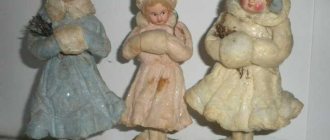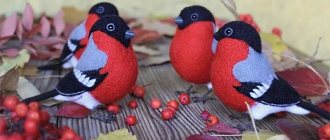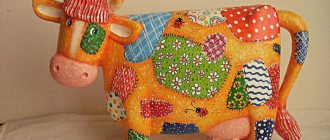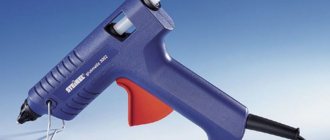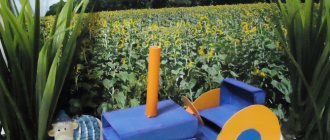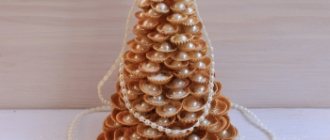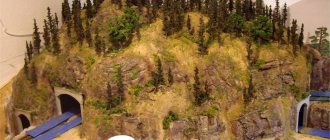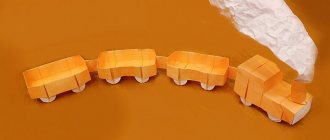Preparing your desktop
First of all, you need to prepare your table on which you will work. There should be no unnecessary things on it and every tool should be at hand. Not everyone has their own desktop and has probably already thought about creating one. Making a table is not difficult, but choosing a place for it in the house is difficult. The ideal option is an insulated balcony, on which you can do crafts at any time. I have already written about preparing the table in a separate article and tried to describe in as much detail as possible the entire process of creating it. If you don’t know how to prepare your workplace, then read the following Article. After you have completed the process of creating a table, try to start choosing your future craft.
How to make a train with your own hands
Many people have probably seen or even bought trains for their children, or maybe even entire railroads as toys for their beloved children.
What if you try to make a train with your own hands?
Materials for making a train:
Wooden block 50*50 or 100*100 at your discretion. length from 50 cm;
Pieces of wood (we use pine, oak) details below;
Tools for making a train
:
Electric drill + preferably a milling machine or engraver;
Clamp or vice;
Grinding machine or grinding machine;
Drills + feather drill + cutters;
We choose quality material
The main material is plywood. The choice is always difficult. Each of us has probably encountered such a problem as delamination of plywood from the end part and asked the question, what causes this delamination? Well, of course, this is mainly due to low-quality plywood. If this is not the first time you have picked up a jigsaw, then you can select plywood from the remnants of a previous craft. If you are new to sawing and you don’t have plywood, then buy it at a hardware store. Choosing material for sawing is always difficult. You should always choose plywood carefully, often look at the defects of the wood (knots, cracks) and draw conclusions. The difficulty in choosing plywood lies in the fact that no matter how you guess at its defects and shelf life. For example, you bought plywood, cleaned it, translated the drawing and suddenly it began to delaminate. Of course, this has happened to almost everyone and it’s oh, how unpleasant. So it is better to pay attention when choosing and choose good plywood. I wrote a special Article in which all the principles of choosing plywood are described step by step.
Stripping plywood
We clean our plywood with sandpaper. As you already know, “Medium-grained” and “Fine-grained” sandpaper is used for cleaning plywood when sawing. You've probably seen sandpaper in hardware stores, and that's what we'll need. In your work you will need “Coarse-grained”, “Medium-grained” and “Fine-grained” sandpaper. Each of them has its own property, but a completely different coating, by which it is classified. “Coarse-grained” sandpaper is used for processing rough plywood, i.e. which has many defects, chips, and cracks. “Medium-grained” sandpaper is used for processing plywood after “Coarse” sandpaper and has a slight coating. “Fine-grained” or otherwise “Nulevka”. This sandpaper serves as the final process for stripping plywood. It gives the plywood smoothness, and therefore the plywood will be pleasant to the touch. Sand the prepared plywood in stages, starting with medium-grain sandpaper and ending with fine sandpaper. Sanding should be done along the layers, not across. A well-polished surface should be flat, completely smooth, glossy in the light and silky to the touch. How best to prepare plywood for sawing and which sandpaper is best to choose Read here. After stripping, check the plywood for burrs and small irregularities. If there are no visible defects, then you can proceed to the process of translating the drawing.
Flower garden Steam locomotive in the design of a garden or cottage
To successfully create a Flower Engine flower garden with your own hands, you need to know some subtleties. This applies to the choice of location, flower crops, and beautiful design. For greater harmony, the flower bed in the garden can be made in a contrasting version or in a single color. In this case, the general concept of landscape design must be observed.
A flower garden can be made quite simply from any available materials.
It is best if perennial flowers are a priority - they are good to use as a base. But annual plants are perfect for creating a background, which, if necessary, can be replaced the next season.
Among the most popular flowers suitable for the spectacular design of a tall flowerbed, the Engine, include:
- petunia;
- sulfinia;
- ampelous pelargonium;
- pelargonium;
- climbing begonia;
- campanula;
- lobelia.
If you use boxes with medium height, as well as low ones, then you should use:
- marigold;
- verbena;
- purslane;
- primrose;
- daisies;
- pansies;
- aubriettes;
- phlox subulate;
- Turkish carnations;
- miniature chrysanthemums;
- bearded irises.
The flowerbed of the Engine will be beautifully and usefully landscaped with the help of such fragrant and spicy herbs:
Translation of the drawing
For me, drawing translation has always been the main process in my work. I will tell you a couple of rules, as well as tips for high-quality translation of a drawing. Many people transfer the drawing onto plywood not only using a pencil and copying, but also using “Black Tape”, glue the drawing to the plywood, then wash off the drawing with water and the markings of the drawing remain on the plywood. In general, there are many ways, but I will tell you about the most common method. To transfer the drawing onto prepared plywood, you must use a copy, a ruler, a sharp pencil and a non-writing pen. Fasten the drawing in plywood using buttons or simply hold it with your left hand. Check if the drawing fits the dimensions. Arrange the clock drawing so that you can use a sheet of plywood as economically as possible. Translate the drawing using a non-writing pen and ruler. There is no need to rush, because your future craft depends on the drawing.
Good day, dear reader! Today we will step by step look at the process of making a children's playground - a steam locomotive made of wood. We will manufacture it according to a detailed description, drawings and sketches, so there should be no questions in production, and it is also not necessary to have the profession of a joiner or carpenter. Any man who knows how to hammer a nail into a wall can make it. You can involve your children or grandchildren in construction, combine family vacations with interesting, shared work, the kids will remember this for a long time!
We will also calculate the amount of material needed and its cost, and at the end of the article we will find out how much it will cost us to make a steam locomotive with all the consumables if we make it ourselves. The overall dimensions of our locomotive are indicated in this sketch.
We will make a steam locomotive from edged pine or spruce boards of two types: 40 x 100 mm and 25 x 150 mm, it is better to purchase a length of 6 meters, but for ease of transportation you can buy 3 meters each, and try to immediately distribute the parts on the board to reduce waste. This material was not chosen by chance; its strength is quite sufficient for this product, and it can also be purchased in any store or market.
To make a steam locomotive, the following tools are required: crosscut or circular saw, electric. a jigsaw, a screwdriver with a couple of bits for these screws, a grinder, and ordinary carpentry tools: a hacksaw, an ax, a hammer, a chisel, a square, a pencil, a tape measure.
So, we begin production by constructing the base frame. It is made of edged boards 25 x 150 mm, we mark and cut the blanks; to achieve a tight fit and achieve the required strength, it is better to use a trimmer. We assemble the base according to the drawing. Throughout the entire assembly we use wood screws; they do not rust or paint the wood outdoors. It is also advisable to treat the parts before assembly with wood antiseptics in order to avoid blue staining, mold and mildew, and treat them again after assembly, before applying paint and varnish.
Next, we mark, cut out and assemble the vertical frame for the booth and the front of the locomotive, use a 40 x 100 mm board, the top of the short posts is sawn at an angle of 45 degrees.
Then we lay the floor. For the front frame posts, we make rectangular holes in the floorboard using a jigsaw or chisel. Between the booth posts, to close the gap, we make an extension 40 x 75 mm and 750 mm long, spreading the board 40 x 100 lengthwise.
Next, we sew up two side sides of the booth from a board 25 x 150 mm and a length of 950 mm, one side takes 8 whole ones, and we split one board in half lengthwise, and screw one half at the top of each side. Then we install six short boards 150 x 25 mm, 130 mm long, between the booth and the front frame. We measure out the windows on the sides and cut them out later.
I almost forgot: you can join all the side and floor boards tightly or through a nail, with a gap of 2-3 mm. For outdoor use, it is better to do it at a distance, this way moisture will not accumulate and the board will be better ventilated and dried. In the drawings, all dimensions are indicated for the end-to-end option, so if you want to install boards with a gap, then you need to go through the side of each board with a plane, remove two millimeters, make the width not 150 mm, but 148 mm!!!
Next, we make two boards with an arc for the frame of the booth roof. We are finishing the front frame, the corners are filed at 45 degrees.
Then we sew up the roof of the booth, adjust the boards tightly so that it doesn’t drip on your head, you can apply silicone to the joints of the boards. Next, we measure the windows, install two armrests under the windows from the inside and two armrests from the outside, spreading the board 40 x 100 mm lengthwise, we get an armrest width of 50 mm. Next, we install reinforcement on the windows, two racks from the inside on each side, thanks to this, after cutting out the windows, the short ones will not dangle, you will get a rigid structure, for this we make racks in the same way as for the armrests, only from a 25 mm board. We cut out the windows.
We make benches from two boards 25 x 150 mm, 980 mm long, and four supports, 350 mm long.
Next, we screw two boards 1030 mm long between the booth and the front frame. We take a jigsaw and cut along the contour of the front frame.
Then we sew up the front frame with 25 x 150 mm boards, 1025 mm long. We make an extension from a board 40 x 100 mm, spreading it lengthwise, the thickness is 40 mm and the width is 75 mm. We install it where it is highlighted on the drawing on both sides.
Next, we make the platband for the extensions that we just looked at, we make it from a 150 by 25 mm board, spreading it lengthwise to a width of 75 mm and a length of 2200 mm.
Next, we manufacture and install the front scraper according to the drawing.
Then we make and attach the stands on which the locomotive will stand, and then we will cover them with wheels. The racks are made of two parts, 300 mm long from a 40 x 100 mm board, and a 260 mm long rack from a 25 mm board with a width of 75 mm, cutting the board in half. Install the racks according to the drawing, symmetrically on both sides.
Then we make small wheels. They consist of two parts: the first part is a circle with a diameter of 300 mm, the other part consists of two arcs and a circle inside. For connection, the seam of the joint of the boards of the first circle must be perpendicular to the seam of the arcs, as in the drawing. The wheels are assembled using self-tapping screws from the inside so that their caps are not visible.
We also make four large wheels, but they are 450mm in diameter (three boards), the manufacturing principle is the same. We are not installing small and large wheels yet.
Next we make a short pipe. All elements are made from boards 25 x 150 mm, and long racks 75 mm wide are made from any material 10 mm thick, preferably from lining.
Then we make a long pipe, the principle is the same, the racks are 40 mm wide, we make them from lining 10 mm thick, we do not install the pipes yet.
Next we will start making rails and sleepers. For sleepers we use a 25 x 150 mm board with a length of 1500 mm, we need seven pieces. We place the sleepers so that the racks on which the locomotive stands, and where we will attach the wheels, stand exactly on the sleepers. For rails we use a board 40 x 100 mm, rail length 2500 mm. The internal distance between the rails will be 980 mm. We attach the rails with sleepers in the place where the locomotive is installed, place the locomotive on them, if everything fits exactly, we tightly fasten the rails with the sleepers and the racks of the locomotive with the rails and sleepers. After assembly, there should not be any rolling of the locomotive on the sleepers, if this is not the case, resort to fastening with metal corners, but the locomotive should stand still.
Then we screw the wheels, the jumper between them, and the pipes onto the locomotive, that's all, the assembly is complete! Now we take a sander and clean all surfaces and corners with sandpaper so that children do not drive in a splinter. Next, we treat it again with a base or antiseptic and apply a paint coating. Our beauty is ready!
Now let's calculate how much it cost us:
Board 40 x 100 mm – 5 pcs. 6 m each = 30 m.p. One 6 m board costs 160 rubles, a total of 800 rubles.
Board 25 x 150 mm – 20 pcs. 6 m each = 120 m.p. One 6 m board costs 150 rubles, a total of 3000 rubles.
Antiseptic 180 rub.
Wood screws: 3.5×45 mm – 1 kg for 115 rubles, 3.5×57 mm – 2 kg for 115 rubles, total 345 rubles.
Domestic wood paint 200 RUR. per kg, 5 kg = 1000 rub. If the paint is imported, then the price will be from 700 rubles. per kg.
In total, we spent 5145 rubles on building materials. (90 USD).
Dear readers, the steam locomotive is part of the playground - there will be a couple more carriages, here is the article “Making carriages for the playground: steam locomotive”. We will arrange them in a circle - an arc, and in the middle there will be a sandbox.
If you liked the material, tell your friends (under the article); if something is not clear, write in the comments, I will definitely answer. If you have interesting ideas about what you would be interested in seeing or reading on this site, or suggestions for developing drawings of any model, write to the contacts on the “about the author” page. I hope the article was useful to you, if you want to financially support the site (as much as you don’t mind), then the wallet number is on the “about the author” page (in the note, write what you liked, for which you are grateful).
Copying and distribution of material and photos is prohibited!
Drilling holes in the parts
As you have already noticed, the parts contain parts of the grooves that need to be cut out from the inside. To cut out such parts, you need to drill holes in them using a hand drill or, as in the old fashioned way, make holes with an awl. By the way, the diameter of the hole must be at least 1 mm, otherwise you can damage the elements of the drawing, which, alas, are sometimes difficult to restore. To avoid damaging your work table when drilling holes, you must place a board under the workpiece so as not to damage the work table. It is always difficult to drill holes alone, so ask a friend to help you in your task.
Sawing parts
There are many rules for cutting, but you need to stick to the most common ones. First of all, you need to cut out the internal parts, only then according to the external pattern. There is no need to rush when cutting. The main thing is to always keep the jigsaw straight at a 90-degree angle when cutting. Cut out the parts along the lines you accurately marked. The movements of the jigsaw should always be smooth up and down. Also, do not forget to monitor your posture. Try to avoid bevels and unevenness. If you go off the line while cutting, don't worry. Such bevels and irregularities can be removed using flat files or “coarse-grained” sandpaper.
Cheerful flower bed Train made from bottles
To obtain a spacious flower bed "Locomotive" from plastic bottles, you will need containers with a volume of 10-30 liters. If you use 5 liter bottles, the flower garden will have miniature dimensions. The main thing is that the “head” of the locomotive is larger than the trailers. This is the only way the flowerbed will have a chic and believable look.
To create an original flower garden you need to follow the following instructions:
- Cut a rectangular window on the side of the bottle; flower crops will be placed in it.
- Secure 2 cross bars with wheels on the other side of the side shelf using self-tapping screws.
- Place the bottle-cars one behind the other, connecting them with a cork. To do this, you need to first apply markings at the points of contact between the neck of the bottle and the bottom, and then use a sharp knife to make a window. The threaded part of the neck is inserted into it and tightened with a stopper. All other plastic containers are joined in the same way.
- The finished structure is painted in bright colors to make it more attractive and lift your spirits. The eyes are made from corks, the smile is painted with paint.
Cleaning Parts
You should always clean the parts of a future craft carefully. At the very beginning of the work, you already sanded the plywood with sandpaper. Now you have to do a small part of stripping the plywood. Using medium-grain sandpaper, sand the edges of the parts and the back of the plywood. “Fine-grained” sandpaper is considered the final stage of cleaning parts. It is better to clean the front part of the parts with fine sandpaper. When processing plywood, take your time. You can also use a rounded file, which is convenient for cleaning the inside of the holes. Try to ensure that the parts come out without burrs or irregularities.
Varnishing crafts
If desired, you can transform our craft by covering it with Wood Varnish, preferably colorless. Read how best to varnish a craft. Try to choose a quality varnish. Varnishing is carried out using a special brush “For glue”. Take your time. Try not to leave visible marks or scratches on the craft.

